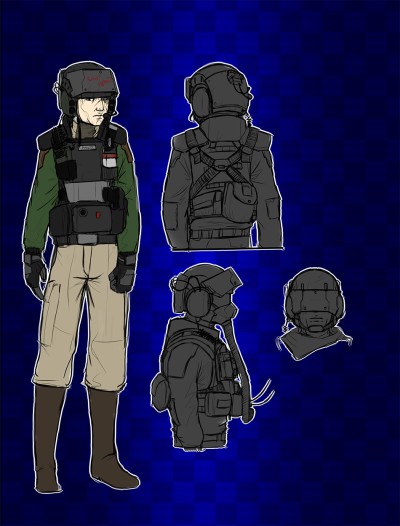Table of Contents
Armored Vehicle Crewmen Uniform
| “A tank is a place full of things you don't want to stub your toe on, and they're all next to your face” - Sgt. Damian Blood |
The AVCU issued for Marines operating inside vehicles that do not support a powered armor pilot where the need for a specialized, non-powered gear arose when the new HMBT came into service. It entered service in YE 37,
Statistical Information
Appearance
The uniform is meant to be worn over the regular NSMC marine uniform, or any other article of clothing.The need for such a dedicated set of equipment arose when Nepleslia's new HMBT came into service, as well as the need for the protection of the crewmen against impacts that are liable to happen when the vehicle move through rough terrain or is hit.
Added with the protection, the biggest feature of the uniform is the capacity for the crew to interact with the vehicle's onboard system, either through a Datajockey, or through the helmet's neural interface.
Components
Jacket
An optional component, the AVCU's jacket is an object of great envy by the common infantryman in the NMSC. The thick fabric is made by an outer layer of fire-retardant fabric,covering the inner layer of soft wool. The jacket can be easily worn or removed by a zipper on the front, and has elastic cuff and waistbands. Thin pads of leather are also stitched onto the elbows and the shoulders, with the latter having the user's rank stitched onto it.
The jacket also comes in several different colors schemes, but the main one is the NSMC green.
Vest
The lightweight vest is designed to protect the wearer against impacts, small arms fire and shrapnel for when outside the vehicle. Different from its heavier counterpart, it is not made for direct confrontations, and its hard components are made from the significantly lighter Steenplast. The plates are secured against a soft layer of a mix between SynAraS and ballistic mesh, and allow the wearer to secure different pouches or extra armor pieces to it, making possible for different configurations.
Despite the possibility of different configurations, one item that always comes standard with the vest is the Life Support Unit, which when hooked to the breathing apparatus can sustain the wearer for one hour with internals. The LSU can also be hooked to the vehicle's onboard equivalent to extend the time.
Statistical Information
- Weight: 8.5kg (~18lbs)
- DR: Tier 2, Medium Anti-Personnel
- Life Support Autonomy: 1 hour when running on internals
Helmet
The AVCU's helmet is composed of a soft, padded layer of SynAraS to cushion the wearer's head against impacts, and a hard shell of Steenplast to protect the wearer against shrapnel or falling debris. The hard shell is supplemented by an extra Steenplast plate on the back, which covers the helmet's battery and electronic components. On the sides, the headgear has an integrated headset, which muffles outside noise and allows the crew to communicate via short-range radio or through their vehicle's intercom system, while to the front of these there is a simple chinstrap to keep the helmet firmly secured.
The visor of the helmet is located on the upper front, and is one of the headgear's main selling points. Once the user slides it down, he can easily interface with the vehicle's optics or weapons by selecting them through the simplified neural interface, or can simply use it as a means of enhanced protection, as the helmet also has a trio of small cameras, which give an near-exact field of vision and depth perception of a normal human eye. If the vehicle has an onboard AI, it can also interact with the HUD by doing things such as highlighting targets or points of interest.
Another piece of equipment that comes with the helmet is the breathing mask to be worn when the crew isn't buttoned down in a hazardous environment. The mask can easily be hooked to the vest's LSU to run on internals.
Statistical Information
- Weight: 1.5kg (3.3lbs)
- DR: Tier 1, Light Anti-Personnel
OOC Notes
This page was originally created on 2015/09/23 09:40 by Foxtrot813.
